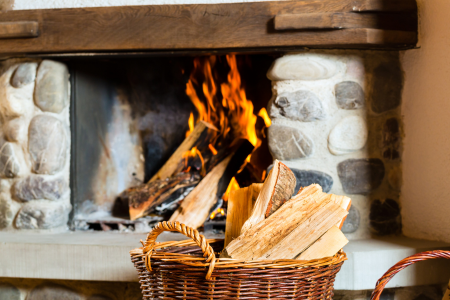If you have a fireplace, there are key facts that you should know about chimney care and safety. Factors like the type of wood to burn, annual maintenance, and chimney caps are essential to safety and proper care. This comprehensive guide will give you the tips that you need.
Regular Maintenance
It is important to have your chimney cleaned once every year. Additionally, you should also have a chimney specialist inspect it for signs of damage or hazards. You need to be sure that the chimney is in safe condition before the cold months arrive and you start lighting your fireplace. If you notice any signs of damage or deterioration, you should have it inspected immediately and avoid lighting fires.
The main reason to have your chimney cleaned every year is because regular use causes buildup of soot and creosote. Soot and other debris will inhibit the airflow and efficiency of your fireplace. Creosote and other materials can also pose a fire hazard when they build up over time.
The best time of year to get your chimney inspected, surprisingly, is not in the fall or on the verge of winter. It is best to schedule inspections during spring or summer to ensure that professionals can perform maintenance or fixes before winter. In colder months, professionals may become overbooked and not able to resolve chimney issues before you need to use it.
The Importance of Chimney Caps
You may notice many chimneys do not have chimney caps, but this is often because the homeowner does not realize the cost savings and other benefits that they provide. Two of the most important reasons to have a chimney cap are to prevent water damage and to keep animals out.
Without a chimney cap, rain, snow, and other precipitation can freely fall into your chimney. Eventually, this is likely to damage the damper, and you will not be able to open and close the chimney properly. When the chimney damper is closed, it is a carbon monoxide risk to use the fireplace. If the damper cannot seal properly when closed due to water damage, the fireplace will be drafty and provide less warmth on chilly days.
Precipitation also wears away at the flue lining, which exists to protect the chimney from catching fire. The mortar joints can also become damaged from water, and this can lead to deterioration of the chimney and a need for costly repairs.
Chimney caps have a wire mesh along the sides that prevent animals from entering without inhibiting ventilation. If birds, squirrels, and other animals enter the chimney, they often cannot get out. Consequently, they die and leave a carcass that can catch fire or attract insects that might infest your home. Furthermore, when animals enter the chimney, their droppings can cause unpleasant smells. Chimney caps are an efficient and economical way to keep pests out.
Considering all the safety concerns of water damage and animal infestations, the bottom line is that every chimney should have a cap. When you prevent blockage and damage, you will save money on repairs. Keeping the chimney free of debris means you will need less firewood to produce adequate heat, yet another reason that a chimney cap saves money.
Choose the Right Type of Firewood
Many fireplace owners are not aware that the type of wood they use can make a significant difference in safety, efficiency, and warmth. Hardwoods are an excellent choice because they burn slower, last longer, and provide greater warmth than softer varieties. Hardwood tree examples are oak, maple, and birch. Hardwood also comes from fruit trees like cherry and apple. Woods from trees that have needles tend to be softer and cheaper, but they are sub-par choices. Softwood comes from trees such as poplar, pine, and fir.
Another crucial factor in choosing firewood is to use “seasoned” wood, which means it has dried for sufficient time after cutting and is free of water content. Freshly cut firewood, also known as “greenwood,” has water content that prevents it from burning properly. Greenwood tends to produce high levels of smoke and steam, but it will not produce much flame.
Other types of wood to avoid burning are construction wood, painted wood, particle board or cardboard, and other types that are not meant for fireplaces. These materials might contain chemicals that will contaminate the air with toxins when burned.
When storing your firewood, place it on dry surfaces like concrete, gravel, or plastic rather than soil. If you want to cover the wood to repel rain, only cover the top so that the wood can have airflow to keep it dry. It is also important not to store wood inside the house because it can attract insects and other pests. Only bring wood indoors when you are ready to burn it. By following these essential tips for taking care of your chimney, you can avoid some common mistakes that can lead to home expenses and repairs. You will save money when your chimney works more efficiently, and you will have peace of mind that your chimney is not a fire hazard or harming the air quality in your home.

